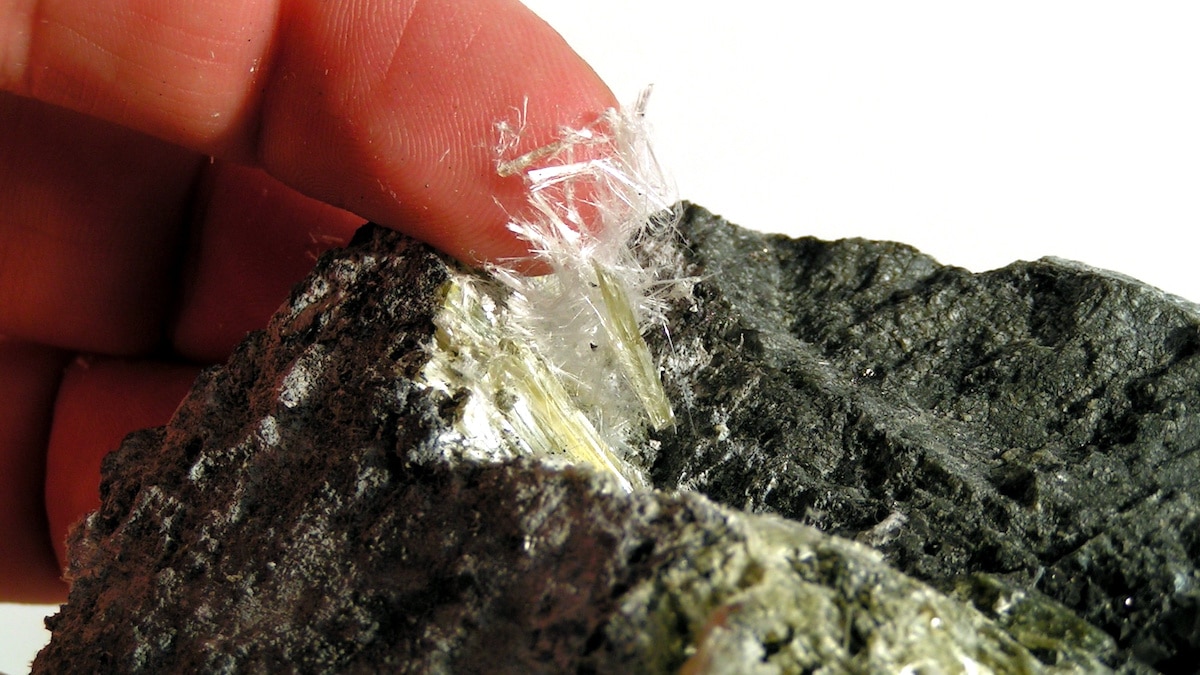

Asbestos in its natural mineral form. fiveheart / iStock / Getty Images Plus
Scientists are exploring how to use asbestos from mining waste to sequester huge amounts of carbon dioxide out of the air to help combat the climate crisis.
Asbestos is a naturally occurring mineral that was once widely used as building insulation and flame retardant. Those uses ceased as its carcinogenic qualities became known, but it is still used in the chlorine industry, for some automotive brakes and in ceiling and roof tiles. While 67 countries currently ban the fibrous material, the U.S. is not one of them.
Now, researchers are focused on certain kinds of fibrous asbestos that are produced as a waste product from mining. The very quality that makes asbestos hazardous to inhale could also make it well equipped to grab carbon dioxide particles that are floating through the air or dissolved in rainwater, reported Eos. The high surface area of the fibers makes them “highly reactive and readily able to transform” into harmless carbonates when mixed with carbon dioxide, the report detailed. This process occurs naturally when asbestos is exposed to the greenhouse gas.
According to MIT Technology Review, these stable materials could lock away greenhouse gases for millions of years and prove to be a viable option for a mass drawdown of carbon dioxide from the atmosphere. Scientists hope to first offset the “ample” carbon emissions from mining activities and then to expand efforts to draw down greenhouse gases.
“Decarbonizing mines in the next decade is just helping us to build confidence and know-how to actually mine for the purpose of negative emissions,” Gregory Dipple, a leading researcher in the field, told MIT Technology Review.
Mineralization also occurs when these materials enter the oceans via runoff and marine life use the ions to make their shells and skeleton that ultimately end up as limestone and other rock that traps carbon, Jackson Bird, host of the Kottke Ride Home Podcast, reported.
Carbon sequestration is a necessary tool in the fight to reduce the amount of carbon dioxide in our atmosphere. Without it, it is unlikely that we will meet our “carbon goals” and stave off the very worst consequences of the climate crisis.
Scientists are also exploring how to use waste products from other types of mining, like nickel, copper, diamond and platinum, to capture carbon. They estimate there could be more than enough materials to lock away all the carbon dioxide humans have ever emitted, and more, Bird reported.
Right now, most of that is locked away in solid rock that is never exposed to air, which would kickstart those chemical reactions. That’s why scientists studying carbon removal are trying to find ways to increase exposure and to accelerate this usually slow reaction to transform mining waste into a powerful agent to fight the climate crisis.
The MIT report details how many of the interventions being tested attempt to increase the reactive surface area of material exposed to carbon dioxide by digging the materials up, grinding them into finer particles, and spreading them into thin layers that are fanned across with air. Others call for heating or adding acid to the compounds. Some are even using bacterial mats to jumpstart the chemical reaction, Eos reported.
“We are looking to accelerate this process and transition it from a pile of asbestos waste to a deposit of carbonate mineral which is completely harmless,” said Jenine McCutcheon, a geomicrobiologist working to turn abandoned asbestos tailings into harmless magnesium carbonate, reported Eos. Gymnasts and rock climbers use a white powder version of the material to improve their grip.
“This is the giant, untapped opportunity that could remove enormous amounts of CO2,” Roger Aines, head of the Carbon Initiative at Lawrence Livermore National Lab, told the MIT Technology Review.
Supporters of the new strategy have concerns about the cost and land limitations, the report continued. The process is expensive compared to other drawdown technologies like planting trees. It also could require vast amounts of land to spread out enough newly unearthed materials to make a significant carbon drawdown, making it harder to scale up.
Bird also noted the concern that the entire process could be energy intensive, which, if not carefully balanced, could offset the carbon capture benefits it is attempting to create.
Finally, there are numerous concerns surrounding the toxicity of these materials and the safety in handing them. Spreading asbestos dust onto land and/or fanning it to increase air flow has raised safety concerns for workers and populations nearby, the MIT Technology Review noted.
Nevertheless, the new process could be a “promising option to add to a slew of other solutions as we all know there will not be one quick fix panacea that will solve the climate crisis,” Bird concluded.
- Asbestos, Ubiquitous and Unavoidable, Is a Deadly Threat to Our Kids
- Trump's Toxic Wake: 10 Ways the EPA Has Made Life More ...
- Why Asbestos Is Still a Major Public Health Threat in the U.S. ...
- Using Captured CO2 in Everyday Products Could Help Fight Climate Change, But Will Consumers Want Them?

 233k
233k  41k
41k  Subscribe
Subscribe 